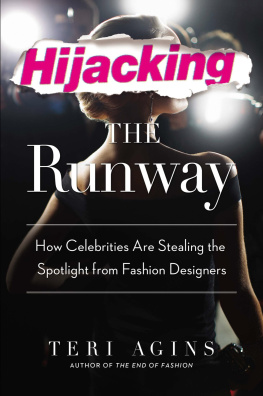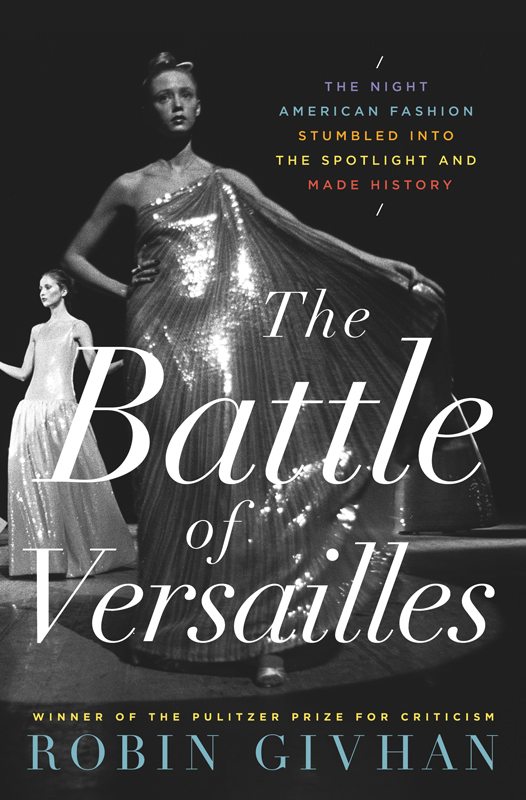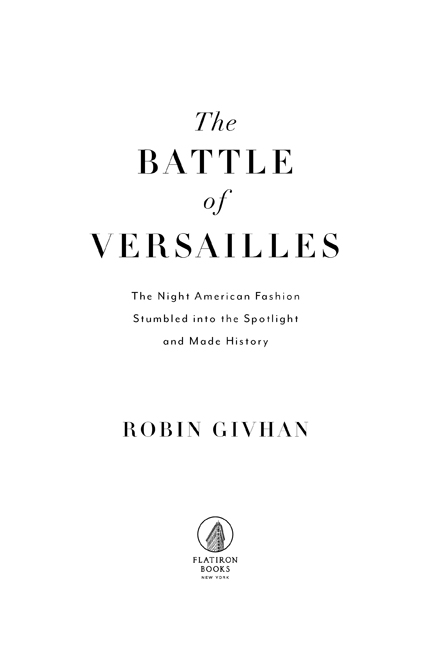Givhan - The battle of Versailles : the night American fashion stumbled into the spotlight and made history
Here you can read online Givhan - The battle of Versailles : the night American fashion stumbled into the spotlight and made history full text of the book (entire story) in english for free. Download pdf and epub, get meaning, cover and reviews about this ebook. City: Frankrike, year: 2015, publisher: Flatiron Books, genre: Non-fiction. Description of the work, (preface) as well as reviews are available. Best literature library LitArk.com created for fans of good reading and offers a wide selection of genres:
Romance novel
Science fiction
Adventure
Detective
Science
History
Home and family
Prose
Art
Politics
Computer
Non-fiction
Religion
Business
Children
Humor
Choose a favorite category and find really read worthwhile books. Enjoy immersion in the world of imagination, feel the emotions of the characters or learn something new for yourself, make an fascinating discovery.

- Book:The battle of Versailles : the night American fashion stumbled into the spotlight and made history
- Author:
- Publisher:Flatiron Books
- Genre:
- Year:2015
- City:Frankrike
- Rating:3 / 5
- Favourites:Add to favourites
- Your mark:
The battle of Versailles : the night American fashion stumbled into the spotlight and made history: summary, description and annotation
We offer to read an annotation, description, summary or preface (depends on what the author of the book "The battle of Versailles : the night American fashion stumbled into the spotlight and made history" wrote himself). If you haven't found the necessary information about the book — write in the comments, we will try to find it.
A Washington Post Notable Book of 2015
It was a big deal when American fashion went to Versailles. Who better than Robin Givhan to tell this captivating story? - Diane von Furstenberg
On November 28, 1973, the worlds social elite gathered at the Palace of Versailles for an international fashion show. By the time the curtain came down on the evenings spectacle, history had been made and the industry had been forever transformed. This is that story.
Conceived as a fund-raiser for the restoration of King Louis XIVs palace, in the late fall of 1973, five top American designers faced off against five top French designers in an over-the-top runway extravaganza. An audience filled with celebrities and international jet-setters, including Princess Grace of Monaco, the Duchess of Windsor, Paloma Picasso, and Andy Warhol, were treated to an opulent performance featuring Liza Minnelli, Josephine Baker, and Rudolph Nureyev. What they saw would forever alter the history of fashion.
The Americans at the Battle of Versailles- Oscar de la Renta, Bill Blass, Anne Klein, Halston, and Stephen Burrows - showed their work against the five French designers considered the best in the world - Yves Saint Laurent, Hubert de Givenchy, Pierre Cardin, Emanuel Ungaro, and Marc Bohan of Christian Dior. Plagued by in-fighting, outsized egos, shoestring budgets, and innumerable technical difficulties, the American contingent had little chance of meeting the Europeans exquisite and refined standards. But against all odds, the American energy and the domination by the fearless models (ten of whom, in a groundbreaking move, were African American) sent the audience reeling. By the end of the evening, the Americans had officially taken their place on the worlds stage, prompting a major shift in the way race, gender, sexuality, and economics would be treated in fashion for decades to come. As the curtain came down on The Battle of Versailles, American fashion was born; no longer would the world look to Europe to determine the stylistic trends of the day, from here forward, American sensibility and taste would command the worlds attention.
Pulitzer-Prize winning fashion journalist Robin Givhan offers a lively and meticulously well-researched account of this unique event. The Battle of Versailles is a sharp, engaging cultural history; this intimate examination of a single moment shows us how the world of fashion as we know it came to be.
Givhan: author's other books
Who wrote The battle of Versailles : the night American fashion stumbled into the spotlight and made history? Find out the surname, the name of the author of the book and a list of all author's works by series.










